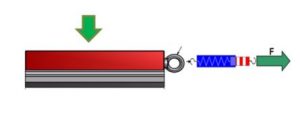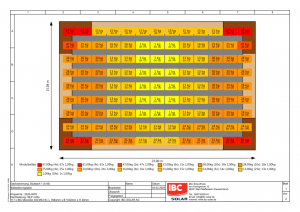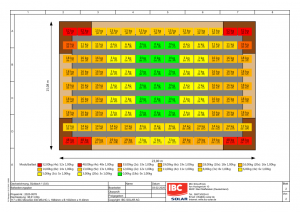
In the flat roof sector, aerodynamic mounting systems have evolved, especially for foil, bitumen, green and gravel roofs. The reason for this success is the simple assembly compared to other systems, as normally no roof penetrations have to be made and better load values are achieved through the aerodynamics. Instead, ballast is only applied depending on the project. In this context, the so-called static friction coefficient between the bracket and the roof cladding plays an important role in all aerodynamic systems on the market, for example in our IBC AeroFix and IBC AeroFlat systems, because it strongly influences the ballast. How this is determined exactly and what needs to be taken into account is explained in more detail below.

In order to calculate the correct ballasting of the system, the system planning must be carefully carried out. For this purpose, the information about the building dimensions, roof pitch, roof covering and terrain category are important. In addition, the lower the ballast, the better. In order to keep it as low as possible, the in-house mounting systems AeroFix and AeroFlat are tested in detail in the boundary layer wind tunnel, before the market launch. For the general stability of the mounting systems, the weight of the PV system against possible shifting and lift-off must be calculated for each individual project. The higher ballast from both cases is then selected. Because at least two rows are connected by the stable floor rail, the proof against tipping can be neglected. Another factor that strongly influences ballasting is the static friction coefficient.
Due to the large number of roofing membrane manufacturers and depending on the age of the roof, the coefficient of static friction can vary. For a first very rough planning, a theoretical assumption of the value is possible for the time being. If the planning then becomes more concrete, the static friction on the roof must be measured. This can already be done at the time when the roof is measured for detailed planning. In this way, the installer and the system operator ensure that they have the correct ballast calculation for the project right from the start. After all, what could be more accurate than measuring the coefficient of static friction directly on the roof covering, where the PV system will be located later on? For this purpose, IBC SOLAR has a static friction meter and a static friction protocol in its portfolio. The static friction protocol is part of the system documentation and must be provided accordingly.
The ratio ballasting – static friction coefficients
It is relatively easy to carry out the tests to determine the coefficient of static friction. Five tests are carried out in dry and wet conditions, evenly distributed over the entire roof surface. Visually different roof areas are to be examined separately from each other and repeated there as well. The test specimen is placed on the roofing with the correct building protection mat. For bitumen roofs the normal building protection mat is used. For foil roofs, however, an aluminum-laminated building protection mat is used. The aluminum layer prevents the migration of plasticizers between the film and the building protection mat, which prevents cracking due to embrittlement of the film. Via the tension spring, the force is then applied centrally and parallel to the 10kg test specimen by the measuring device and measured with the spring balance. The force is to be applied evenly and the measurement should be made in the direction of the eaves. To determine the coefficient of friction, the maximum force that occurs before the test specimen is moved is decisive. From all measurements (wet and dry), the worst or lowest coefficient of static friction must then be used for the subsequent ballast calculation. An average of all measurement results is not permitted due to a possible risk of the system slipping at the lowest static friction.
If a force of 60 N is measured with the spring balance as described above, the static friction value in this measurement is 0.6 µ
The example shows the dependence of ballast and static friction coefficient. If one changes, it will have an immediate effect on the other, while all other information, such as location, building and module arrangement will not change.

Information for the calculation
- Location: Bad Staffelstein
- Terrain category III
- Building dimensions L: 23 m W: 15 m H: 7.6 m roof pitch 6 °
- static friction
- Figure 1: 0.45 µ
- Figure 2: 0.6 µ
Conclusion
Just because the coefficient of static friction in Figure 2 is better, you can save over a ton of ballast. However, the actual savings are not only the price of the lower ballast, but also the logistics and working time involved in assembling and distributing the ballast on the roof. In addition, the load reserve of the roof can be decisive in determining whether a PV system can be built at all.
The coefficient of static friction is often neglected because the relevant calculations are either not known or it is not known how to measure it. Another reason is often the lack of time. As explained above, the exact determination requires measurements on the roof. Unfortunately there is no way around this. Therefore, one must inevitably plan a trip to the building, regardless of how far it is from the personal location. But if you see the changes in the ballast, a measurement is useful and important. Another reason why the extra effort is worthwhile in advance: In case of a complaint, you will have far more problems without a measurement being carried out and it is highly likely that you will be burdened with the expense of the damage.
Author: Johannes Cayé (Product Manager)